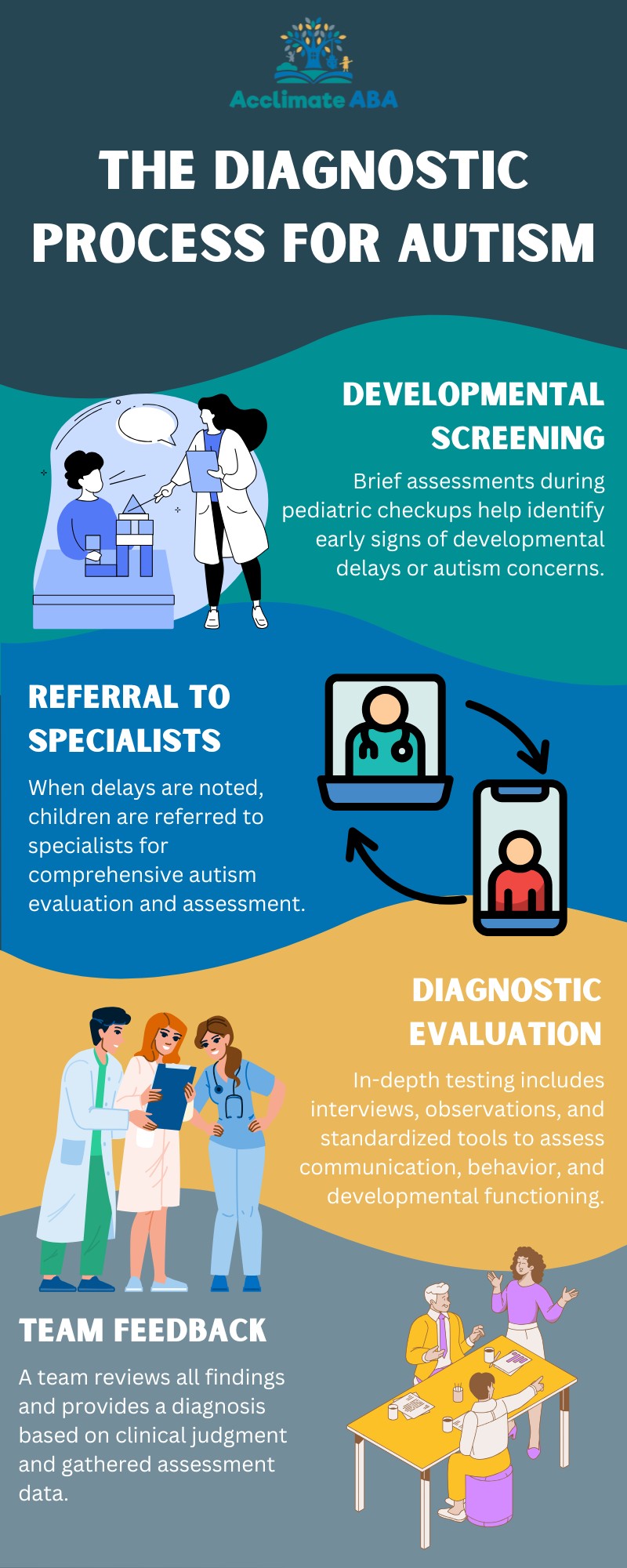Key Points:
- Autism can often be diagnosed reliably by age 2, but signs may appear as early as 12 to 18 months.
- Early diagnosis allows for earlier intervention and support through services like ABA therapy.
- The age of diagnosis can vary depending on symptom severity, family awareness, and access to specialists.
Understanding at what age autism is diagnosed is a major concern for many parents. The journey often begins when developmental milestones aren’t being met or certain behaviors seem different from neurotypical peers. According to the CDC, autism spectrum disorder (ASD) affects approximately 1 in 31 children in the U.S., and early detection can make a significant difference in a child’s development.
For many families, the question “at what age is autism diagnosed?” becomes pressing when signs of communication delays, limited eye contact, or repetitive behaviors emerge. While autism can be reliably diagnosed by the age of 2, many children aren’t diagnosed until later, often due to subtle symptoms or limited access to specialists.
At What Age Is Autism Diagnosed?
Autism can typically be diagnosed as early as 18 to 24 months, with reliable diagnoses possible by age 2. However, milder cases or those with more subtle symptoms may not be recognized until preschool or school age.
A diagnosis of autism spectrum disorder depends on careful observation, developmental screening, and standardized diagnostic tools. Pediatricians often conduct initial screenings at 18- and 24-month well-child visits. If red flags appear, children are referred to specialists like developmental pediatricians or child psychologists.
What Are the Earliest Signs of Autism in Young Children?
Parents are often the first to notice differences in behavior, but not all early signs are obvious. Subtle differences in social and communication skills can appear during infancy. Recognizing these patterns early helps reduce delays in diagnosis.
Some of the earliest red flags include:
- Limited or no eye contact by 6 months
- No response to name by 12 months
- Delayed babbling or gestures like pointing
These signs don’t confirm autism, but they signal a need for further evaluation. Developmental screenings are essential in identifying these concerns.
What Factors Affect the Age of Diagnosis?
While some children receive an autism diagnosis by age 2, others are diagnosed much later. Several variables can influence the timing of identification. Below are some common examples:
1. Severity of Symptoms
Children with more pronounced communication delays or behavioral differences are often identified and diagnosed earlier. Clearer signs of autism typically prompt faster referrals to specialists and earlier intervention services.
2. Access to Healthcare Services
Limited access to developmental screenings and specialists—especially in rural or underserved areas—can delay diagnosis. Waitlists, cost, and geographic barriers all play a role in how quickly families receive help.
3. Parental Awareness and Advocacy
Parents who are knowledgeable about developmental milestones and autism signs are more likely to notice early red flags. Their proactive efforts often lead to earlier evaluations and faster diagnoses.
4. Gender Differences
Girls may be diagnosed later due to subtler symptoms, stronger social imitation skills, or masking behaviors. These differences can cause autism traits to be overlooked or misattributed to other conditions.
5. Cultural and Socioeconomic Factors
Cultural beliefs, language barriers, and financial limitations may impact how symptoms are interpreted or when care is sought. These factors can significantly delay autism identification and access to appropriate support.
What Is the Diagnostic Process for Autism?
Diagnosis of autism spectrum disorder is comprehensive and includes multiple steps. The process involves input from parents, pediatricians, and specialists. It also uses formal tools designed to measure development and behavior.
The process typically includes:

Early intervention services, including ABA therapy, often begin soon after diagnosis.
Why Early Diagnosis Matters
Early diagnosis of autism is important because it allows children to receive intervention during the most critical stages of brain development. Therapies like ABA, speech, and occupational therapy are most effective when started early, helping improve communication, behavior, and social skills.
It also gives families clarity and direction. Understanding a child’s needs sooner can reduce stress, guide effective parenting strategies, and open access to vital resources and school accommodations. With early support, children have a better chance of reaching their full potential and building meaningful connections with the world around them.
How Can Parents Prepare for an Autism Evaluation?
If a pediatrician recommends an evaluation, it can feel overwhelming. Being prepared can ease the process. Keeping records of your child’s development, behavior patterns, and any concerns can be helpful.
Here are some steps parents can take:
1. Keep a Journal of Observations
Track your child’s behaviors, communication, social interactions, and sensory responses over time. Specific examples—like avoiding eye contact or repetitive movements—can provide valuable insight for evaluators during the diagnostic process.
2. Gather Videos of Daily Interactions
Short clips of your child at home, during play, or in routine activities can help professionals observe natural behavior patterns that might not appear during the evaluation session.
3. Collect Feedback from Teachers
Educators often notice social and communication differences in group settings. Their input offers a broader picture of your child’s interactions, especially outside of the home environment.
4. Bring Completed Developmental Checklists
Fill out any screening tools provided before the appointment. These structured forms help professionals compare your child’s development with age-based expectations and spot any patterns or delays.
5. Ask Questions Throughout the Process
Don’t hesitate to ask for clarification during evaluations. Understanding what each step means helps you feel more confident, informed, and empowered as your child’s advocate throughout the diagnostic journey.
It’s okay to ask questions throughout the evaluation process. Understanding each step helps parents become effective advocates.
How Do Diagnostic Criteria Vary With Age?
Diagnostic criteria for autism are consistent across ages, but how they appear in children can vary significantly. In toddlers, symptoms are usually behavioral and social, while older children might show more challenges with abstract thinking, peer relationships, or emotional regulation.
For younger children, clinicians focus on:
- Delayed language development
- Lack of joint attention (sharing experiences by looking or pointing)
- Social withdrawal or minimal social smiling
In older children, differences may show up as:
- Difficulty with peer interactions
- Intense, narrow interests
- Trouble understanding social norms
The consistency of symptoms across environments (home, school) is a critical aspect of diagnosis.
Nurture Your Child’s Potential With ABA Therapy
After finding answers to “at what age is autism diagnosed,” many families begin looking for effective treatment options. Applied Behavior Analysis (ABA) therapy remains one of the most research-supported approaches for children with autism.
Acclimate ABA offers customized ABA therapy in Utah, supporting families with evidence-based strategies that help children develop communication, social, and adaptive living skills.
Contact us today to learn how we can help your child thrive after an autism diagnosis. Early intervention matters, and we’re here to support your journey with compassion and expertise.


